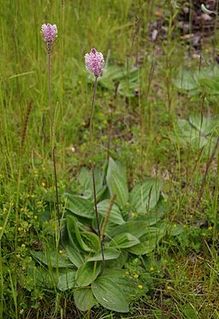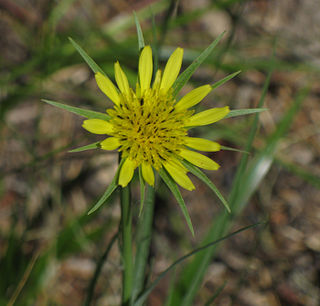
Tragopogon, also known as goatsbeard or salsify, is a genus of flowering plants in the sunflower family. It includes the vegetable known as salsify, as well as a number of common wild flowers.

Timothy is an abundant perennial grass native to most of Europe except for the Mediterranean region. It is also known as timothy-grass, meadow cat's-tail or common cat's tail. It is a member of the genus Phleum, consisting of about 15 species of annual and perennial grasses.

Poa pratensis, commonly known as Kentucky bluegrass, smooth meadow-grass, or common meadow-grass, is a perennial species of grass native to practically all of Europe, North Asia and the mountains of Algeria and Morocco. Although the species is spread over all of the cool, humid parts of the United States, it is not native to North America. The Spanish Empire brought the seeds of Kentucky bluegrass to the New World in mixtures with other grasses. In its native range, Poa pratensis forms a valuable pasture plant, characteristic of well-drained, fertile soil. It is also used for making lawns in parks and gardens and has established itself as a common invasive weed across cool moist climates like the Pacific Northwest, and Northeastern United States. When found on native grasslands in Canada, for example, it is considered an unwelcome exotic plant, and is indicative of a disturbed and degraded landscape.

Scorzonera hispanica, commonly known as black salsify or Spanish salsify, also known as black oyster plant, serpent root, viper's herb, viper's grass or simply scorzonera, is a perennial member of the genus Scorzonera in the sunflower family (Asteraceae), cultivated as a root vegetable in the same way as purple salsify, also in the sunflower family. It is native to Southern Europe and cultivated as a crop in Southern and Central Europe. It grows on nutrient poor soils, dry pasture, rocky areas, in thickets and on limy or marly soils of temperate zones.

Tragopogon porrifolius is a plant cultivated for its ornamental flower and edible root. It also grows wild in many places and is one of the most widely known species of the salsify genus, Tragopogon. It is commonly known as purple or common salsify, oyster plant, vegetable oyster, Jerusalem star, Jack go to bed, goatsbeard or simply salsify.

Echium vulgare — known as viper's bugloss and blueweed — is a species of flowering plant in the borage family Boraginaceae. It is native to most of Europe and western and central Asia and it occurs as an introduced species in north-eastern North America, south-western South America and the South Island of New Zealand. The plant root was used in ancient times as a treatment for snake or viper bites. If eaten, the plant is toxic to horses and cattle through the accumulation of pyrrolizidine alkaloids in the liver.

Toxicoscordion venenosum, with the common names death camas and meadow death camas, is a species of flowering plants in the genus Toxicoscordion, of the Melanthiaceae family. It is native to western North America.

Dioscorea communis or Tamus communis is a species of flowering plant in the yam family Dioscoreaceae and is commonly known as black bryony, lady's-seal or black bindweed.

Euphorbia albomarginata, whitemargin sandmat or rattlesnake weed, is a small low-growing perennial, in the spurge family native to desert, chaparral, and grassland habitats of southwestern North America, from southern and central California to Northern Mexico and Louisiana.

Poa annua, or annual meadow grass, is a widespread low-growing turfgrass in temperate climates. Notwithstanding the reference to annual plant in its name, perennial bio-types do exist. This grass may have originated as a hybrid between Poa supina and Poa infirma.

Plantago media, known as the hoary plantain, is a species of flowering plant in the plantain family Plantaginaceae. It is native to central and western Europe, including Great Britain and introduced to parts of the north-east United States. Its generic name is derived from the Latin for sole; like other members of the genus Plantago, it should not be confused with the unrelated plantain, a starchy banana.

Lactuca serriola, also called prickly lettuce, milk thistle, compass plant, and scarole, is an annual or biennial plant in the dandelion tribe within the daisy family. It has a slightly fetid odor and is commonly considered a weed of orchards, roadsides and field crops. It is the closest wild relative of cultivated lettuce.

Tragopogon dubius is a species of salsify native to southern and central Europe and western Asia and found as far north and west as northern France. Although it has been reported from Kashmir and India, recent evidence suggests that specimens from these areas may be a different species. Western salsify has been introduced into North America where it has become widespread, being reported from all the continental United States except for a few in the far south-east, and all provinces of Canada except Newfoundland and the northern territories.

Poa trivialis, is a perennial plant regarded in the US as an ornamental plant. It is part of the grass family.

Oxalis violacea, the violet wood-sorrel, is a perennial plant and herb in the family Oxalidaceae. Oxalis species are also known as sour grass, sour trefoil, and shamrock.

Agrostis capillaris, the common bent, colonial bent, or browntop, is a rhizomatous and stoloniferous perennial in the grass family (Poaceae). It is native to Eurasia and has been widely introduced in many parts of the world. Colonial bent grows in moist grasslands and open meadows, and can also be found in agricultural areas, roadsides, and invading disturbed areas.

Succisa pratensis, also known as devil's-bit or devil's-bit scabious, is a flowering plant in the honeysuckle family Caprifoliaceae. It differs from other similar species in that it has four-lobed flowers, whereas small scabious and field scabious have five lobes and hence it has been placed in a separate genus in the same family. It also grows on damper ground.

Scorzonera humilis, the viper's-grass, is a perennial plant. In Britain it is a rare plant, restricted to moist meadows, in Dorset and Warwick in England, and in South Wales.
Tragopogon miscellus, the Moscow salsify, is a species native to the States of Washington and Idaho. Intensive studies over the course of many years have demonstrated that it originated as an allopolyploid hybrid between T. dubius and T. pratensis, both of which are European species naturalized in the US. Tragopogon miscellus has become established in the wild, reproducing by its own, thus deserving recognition as a species.

Tragopogon orientalis, common name Oriental goat's beard, is a hemicryptophyte herbaceous annual plant in the family Asteraceae,





















